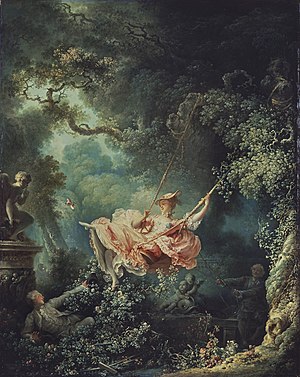I got to thinking about this sculpture today and decided to revisit one of the paintings I had selected that represented an idealisitc life. The philosophy of idealism is to represent things as you would like them to be, rather than how they actually are. I believe it is human nature to have a "grass is greener" attitude.
This tendancy to fantasize about how life could be was prevelant in art during the Rococo movement of the 18th century. Artists of this time were drifting away from the dark, rich works of the Baroque period and moving towards a lighter, more playful and colorful elements. Most often cherubs, myths of love and high society were painted.

The Swing, painted by Jean-Honore Fragonard in the 18th century, is considered one of the masterpieces of the Rococo movement. This painting depicts a young lady being pushed on a swing; while a gentleman hides in the bushes to catch glimpses of her. Cupids and cherubs appear in the lush garden - portraying the playfulness and fantasy of this time. The overall image showcases an idealistic life - however the meaning behind the work is one of deceit and betrayal. On the surface we see what appear to be lovers, the girl and the young man hiding in the greenery. It is believed the man in the shadows pushing the girl is actually her husband; and she is betraying him by allowing the young man to look up her skirt.
This painting is an excellent example of the culture of 18th century France. I love how at first glance it gives the illusion of the perfect life - but when you dig deep and look into the shadows you see real life. The grass may look greener; but there could be slugs and mold growing in the shadows!
No comments:
Post a Comment